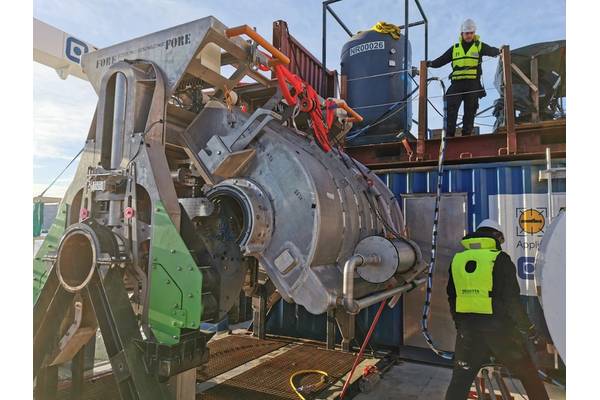
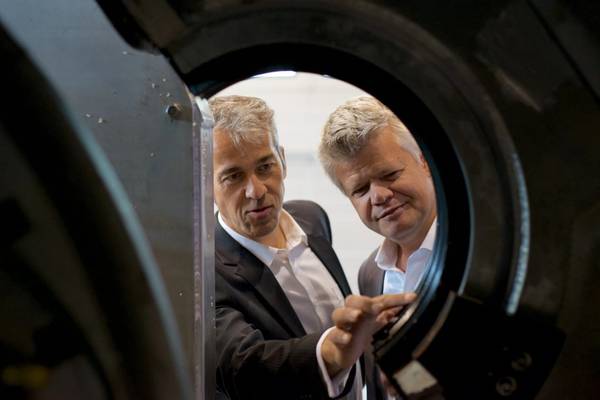
Underwater pipeline repair is an unavoidable and also fairly intensive activity within the offshore industry. There’s a lot of it on the seabed, some of it is old and/or subject to corrosive substances and even damage by anchor or trawler gear. Until now, its repair is largely through installing clamps over specific defects or cutting out and then welding in new sections, when there are multiple defects or a more extensive issue.
Norwegian company Kongsberg Ferrotech has come up with an entirely new solution. The company has developed a self-propelled robotic system for performing close inspection and in-situ composite and soon also 3D printed repairs, to rectify defects, restoring integrity and prevent integrity loss. The company calls it ‘taking the workshop to the defect’ and it’s targeting subsea pipelines and cables.
The company was founded in 2014 in Norway’s Kongsberg region – a strong subsea hub, despite its distance from the sea. CEO Christopher Carlsen comes from FMC Technologies (now part of TechnipFMC), while technical manager Torgeir Bræin was at Equinor and FMC Technologies before that. They’re joined by Lois de la Torre, an entrepreneur who comes with background from coating and pipeline repair industry.
The company’s first target is composite repairs. “Composite repairs are now well-known topside, but there have been relatively few subsea applications,” says Carlsen. “We think that’s mainly due to the difficulty in applying it in a controlled and repeatable way (subsea).” To solve this challenge, over more than five years, the company has built the Nautilus subsea habitat; a self-propelled pipeline inspection and repair system delivering DNV qualified composite repairs even for through-wall defects.
“Nautilus is the first ever robotic solution for inspection, repair and maintenance of subsea pipelines,” says Carlsen. It’s a robotic inspection and repair system that lands over a pipeline defect (already identified and located through internal pigging), then creates a dry controlled habitat in which it can then further inspect the defect, delineate how it needs to be repaired, then prepare the pipeline for repair and then perform the repair.
“A single robot can cater for a range of diameters – you can build a repair clamp, in-situ using polymers and carbon fibre, also cutting out lead times,” says Carlsen. “And it can be deployed from a vessel of opportunity.” To give an idea of its scale, the robot for 8-16in pipelines weighs about 4 tons and measures about 3m x 2m x 3m.
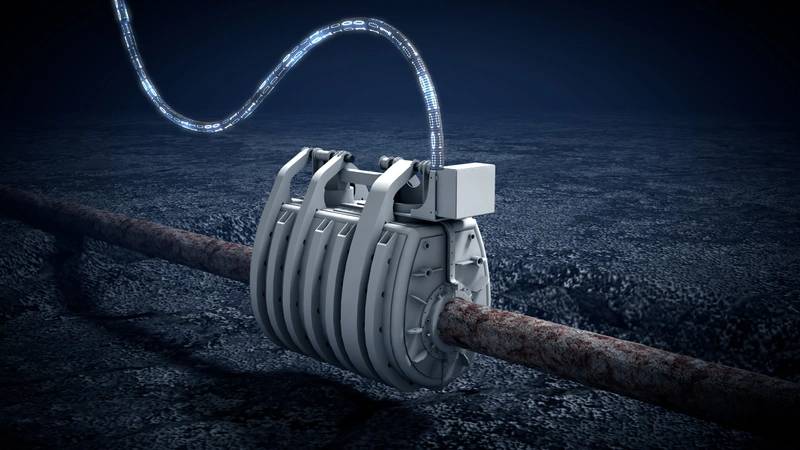 Kongsberg Ferrotech’s Nautilus subsea pipeline repair habitat. Image from Kongsberg Ferrotec
Kongsberg Ferrotech’s Nautilus subsea pipeline repair habitat. Image from Kongsberg Ferrotec
It’s similar to habitats that have been built for carrying out welding on subsea pipelines, except it’s designed to repair rather than replace defects. It’s also self-propelled, using ROV thrusters and guiding aids so that it doesn’t need the support of an ROV or diver to move it into position. It’s been designed to be completely self-contained, including waste material, so all materials produced during the process, such as pipe coating that’s been removed to carry out the repair, are contained and returned to the surface. Throughout, the entire process is monitored by cameras, says Carlsen, so the client can witness it from start to finish. Repairs can cover a range of defects from small pits to through-wall defects, because of the flexibility afforded by applying composite materials, with curing of the polymer using potable water, the firm says.
An in-water test composite repair test using the system was completed in Trondheim Fjord in Norway last year (2020), with a prototype supported initially by an ROV. The technology will be ready to be deployed on commercial applications and operations in Q3 2021, Carlsen says. Kongsberg Ferrotech is initially targeting Southeast Asia where it says there’s a relatively large amount of wet gas production where internal corrosion is a common issue. PTTEP of Thailand has been our partner through the development of the Nautlus, and will also be the pilot client for introducing the service in the region, says Carlsen.
In tandem with commercialising the composite repair system, has been working on adding 3D printing to Nautilus’ capabilities and has recently joined forces with Equinor, SINTEF and Gassco, with Norwegian National Research Council funding and support from part-owner-incubator Kongsberg Innovation to make this happen. Just like the composite repairs, the process would be done inside the Nautilus platform using additive manufacturing techniques to rebuild damaged metal structures in-situ. “It’s like building the equivalent of a steel clamp directly on to the pipeline with off-the-shelf materials and without the waiting time associated with acquiring a clamp,” says Carlsen.
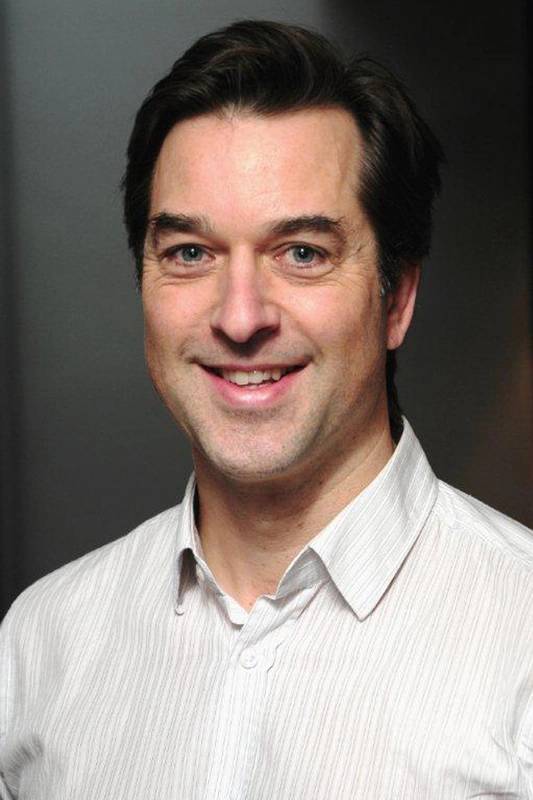 “Normal welding usually involves welding together two pieces of pipe or structures. With AM, you add material to build strength or geometry, that’s the elegance. There is huge potential applying AM and that way of thinking, instead of replacing something, repair it and add lifetime and money. It’s more sustainable.” Brede Lærum, head of 3D printing at Equinor, which is a partner on the first use case for additive manufacturing (AM)
“Normal welding usually involves welding together two pieces of pipe or structures. With AM, you add material to build strength or geometry, that’s the elegance. There is huge potential applying AM and that way of thinking, instead of replacing something, repair it and add lifetime and money. It’s more sustainable.” Brede Lærum, head of 3D printing at Equinor, which is a partner on the first use case for additive manufacturing (AM)
“For a high-pressure application with long lifetime requirements or extending the design life the ideal solution is to make a repair or functional upgrade with the exact same material you have on the flowline,” says Bræin. “With 3D printing you can do that and build up, layer by layer, with different metals, aligned with existing design codes.” As well as creating a repair, Kongsberg Ferrotech has developed technology to create a digital twin of the pipe section, replicating it and the repair, to allow for simulations to be run to ensure that it repair will work. The operator then also has an exact record of their pipeline, its dimensions and how much fibre or welding was done, says Bræin. The firm says the goal ranges from preventive maintenance, to prevent a defect from getting worse, through to full wall loss and significant corrosion repairs.
Brede Lærum, head of 3D printing at Equinor, which is a partner on the first use case for additive manufacturing (AM), says that 3D printing is more or less a robotic welding process, but the difference is how you apply it. “Normal welding usually involves welding together two pieces of pipe or structures,” he says. “With AM, you add material to build strength or geometry, that’s the elegance. You can build something or add material – to a new pipe or structure or an old structure where damage or corrosion or underwater mechanisms have caused damage. We see both topside and subsea, there is huge potential applying AM and that way of thinking, instead of replacing something, repair it and add lifetime and money. It’s more sustainable.”
The potential is almost limitless, he says. “The limit lies in ourselves to imagine what’s possible. This new way of working offers great opportunity. Robotic repair solutions will be an important part of our future.” That will include more and more floating wind turbines, he says, where damage such as cable coating will need to be addressed.
For its first user case with Equinor and Gassco, wire arc additive manufacturing is one of the technologies that could be suitable for AM, says Bræin. The goal is to have this ready to be deployed, with the procedures and design parameters in 2022. After that, the company will then add new processes and solutions, depending on customer requirements. A future development could also be printing new parts onto pipelines that weren’t there originally, this could be to support a tie-in or even decommissioning, adds Bræin.
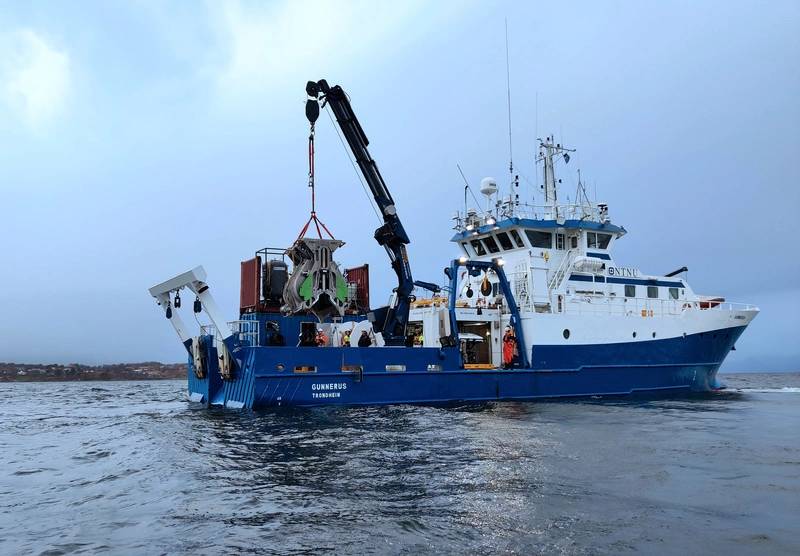 The Nautilus being lowered into the water near Trondheim during tests. Image from Kongsberg Ferrotech.
The Nautilus being lowered into the water near Trondheim during tests. Image from Kongsberg Ferrotech.